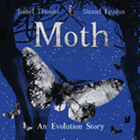
Isabel Thomas and Daniel Egnéus's Moth, about the transformation of the peppered moth (Biston betularia), is endowed with such a sense of wonder, the evolution story is almost elevated to the realm of myth.
It all begins "with a little moth... waking up from a long winter's sleep." "Hungry predators" lurk nearby--the moth flies away, joining other moths trying "not to get eaten." Most have "speckled, freckled wings," although there are a small number born with "wings as dark as charcoal." As the sun rises, the salt and pepper moths blend into the trees, but the charcoal ones stand out. Thomas's poetic yet pragmatic text asks, "Who was the best hidden? Who would survive?" Because the speckled moths have the best camouflage, they're the ones with the highest survival rate. Until the world changes. With the arrival of the Industrial Revolution, the air fills with "smoke and soot." In this "darker" world, the "darkest" moths, with their "charcoal-colored wings," now live long enough to pass on their wing color to offspring--until things change again. Cities begin to green up their acts. "Year by year by year," the air becomes cleaner and "trees shed their sooty bark." The "speckled, freckled" moths can once again blend in, and "today, both colors of moth find places to hide and survive."
Combining watercolors, crayon, acrylics, collage and Photoshop, Egnéus creates stunning visuals that feel soft and organic, yet also intricate and precise. Creative use of color, light and shadow, in addition to intriguing textures and bold shapes, make each spread fascinating to behold. Back matter condenses the evolution of the peppered moth into two pages of historical facts. Moth is a deeply fulfilling look at the ups and downs of natural selection. --Lynn Becker, blogger and host of Book Talk, a monthly online discussion of children's books for SCBWI

